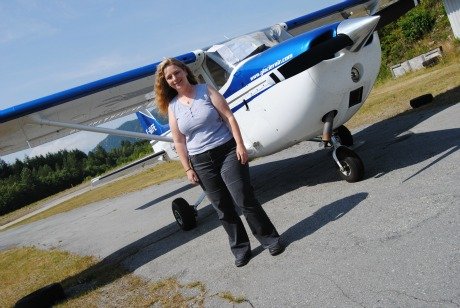
By Gagandeep Ghuman
Published: July 21, 2012
Colette Morin hopes 2012 will grant what has remained elusive for the past ten years at the airport: Stability.
And stability in her business is her closely tied to a long-term lease at the Squamish Airport.
Glacier Air, she says, hasn’t flourished as much as it should because of the short-term leases granted by the district.
“I can’t get a mortgage, I can’t get a building permit, and I can’t expand my business because of short leases,” Morin said.
It’s what led Blackcomb Aviation to shift some of its operations to Pemberton, where the owner has rumoured to have spent $1 million, and hired 14 people.
He could not be reached for comment, but for airport operators, his move underscores the need for urgency on the matter of airport expansion.
Speaking for the Squamish Flying Club, John Hurford said the club supports long-term leases.
“For the flying club, it allows us to finance projects. With financing, we can continue to build things like dry aircraft storage for our existing aircraft,” Hurford said.
Good storage adds to safer flying and to the life of the aircraft,” he added.
Adopted by the council in 1993, it prohibits building permits, subdivisions and rezoning at the Airport, all of which are required to facilitate long‐term leases.
This July, as leases for operators like Glacier Air expire, a new, give-some, take-some, policy is shaping up.
Existing airport tenants will partly or wholly pay for a pipeline in return for long-term leases.
To facilitate that, the district has engaged KWL to see what analysis could be done to determine whether the Cheekeye Fan Policy could be amended or waived to facilitate long-term leases.
KWL proposes a two-phased process.
The first manual assessment, to be done at the cost of $18,000, will provide conclusive insights.
If the manual analysis is not conclusive, additional computer modeling will be required and the cost could increase to $30,000.
That is what should have happened long time ago, Morin says.
The long-term leases, for at least 25 years, would help her expand her business, hire more people, and bring more stability to her business.
Now, a plane has to go all the way to Chilliwack for repairs.
Once she is guaranteed a long-term lease, she can easily expand for a workshop here, build a hangar and rent out the space.
“This place could expand, we can hire people,” she said.


Brad says
I don’t understand why we keep dragging our feet with the airport. We have already been told by the Province the bulk of the Cheekeye Fan lands will be sold and developed for housing, so what is the big added risk with airport expansion? Everything I’ve read says most of the valley floor is a hazard zone, and that the mitigation planned for the Fan probably won’t make a lick of difference in a major catastrophe. Why don’t we drop the facade and a much needed employer expand?
David says
The main objections to airport development has always been excessive noise and the danger of plane crashes. Nothing much has changed over the years. There are valid uses for our “landing strip”, incuding emergency operations and occassioanal tours. I have been given to understand that ILS (Instrument Landing) operations are not possible because of the proximity of high mountains, so only (VOR) landings are possible. This means that the airport cannot be used during periods of low visibility (fog.) In my opinion it is a no-brainer for the District to foster appropriate water and sewage facilities for the existing users. A good example of a really well developed small airport is the one at 108 Mile Ranch. It is very attractive and the amount of traffic is not excessive, yet it serves as a Regional District airport.
Dave says
Should we pull down the Brackendale Schools, the Art Gallery & Store? AND perminently evacuate all households and block all future development in the area because Chicken-lickin says the “sky is falling”?………..By the way I thought I saw some smoke coming out of the side of Mount Garibaldi the other day!!!!….Hmmmm .
Any time now eh?… besides Dec 22nd. 2012 is looming:)
Ed says
I reiterate what “Brad” wrote, there are untold numbers of qualified Aircraft Maintenance Technicians who reside permanently in the valley, besides myself, who commute or travel away from Squamish to maintain full time employment.
Eric Andersen says
Developing opportunities at the airport only makes sense. We can increase the number of high-wage jobs at the airport without adding significantly to airport traffic. Developing the Cheekye Fan for housing does NOT appear to me to make a lot of sense. Where does this conversion of all available valley bottom land to housing use end? We are just asking for future interface problems — and lost opportunity for good industry jobs.
heather gee says
If the Cheekeye Fan Terrain Hazard Policy, adopted by the council in 1993, prohibits building permits, subdivisions and rezoning at the Airport, it also is a major hazard for all people living and working in this valley right through to the oceanfront. When large developers find out what has been hidden from them, they disappear.
The Cheekeye Fan Terrain Hazard is an expensive project to fix and I’m surprised the Provincial Govt or even the Federal Govt. is not insistent upon the safety of Squamish residents.
If Squamish could be upfront and open about the hazard having been fixed, development would flow unhesitantly into this area.